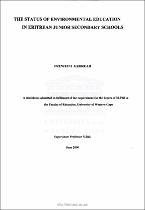| dc.description.abstract | Environmental Education (EE) can be very broadly interpreted to mean all education or narrowly to refer to Nature studies. For the purpose of my minithesis, I used the interpretation of Fier, i.e., Environmental Education as education about, through and for the environment. The central question my minithesis tries to answer is " what is the present status of EE in Eritrean junior secondary schools?" I look at the extent to which EE is included in the education policy of Eritre4 at how EE is included in the curriculum, how it is taught and assessed, the kind of raining available for teachers and the availability of instructional materials for the teaching of EE in Eritrean junior secondary schools. The purpose of this minithesis is to give a broad overview of the present situation with regards to teaching EE. In doing so, I discuss some of the factors that are considered to have a significant influence on the status of EE in Eritrean junior secondary schools. The government of Eritrea for the people of Eritrea has formulated a National Environmental Management Plan (NEMP-E) in 1995. The responsibility for formal EE is in the ambit of the Ministry of Education, which is essentially the policy maker for the formal education sector. However, there seems to be a lack of a comprehensive plan or clear guidelines at a national level for the implementation and support of EE at school level.
In Eritrean junior secondary schools, EE has been included in the Geography, Science and English curricula. The textbooks aim to educate students in knowledge about, through and, for the environment. Despite the positive attitudes teachers had to all three forms of EE, the results revealed that in the classroom teaching, and assessment more emphasis was given to education about the environment, i.e., the emphasis is on information transfer and recall. It appears that some of the reasons why teachers do not fully infuse EE in their classroom might be due to large class size, overcrowded curriculum, short periods, lack of awareness of EE, lack of instructional materials and lack of institutional and administrative support.
Environmental Education was implemented as a subject at the TTI (Teacher Training Institute) in 1995. This implies that teachers before 1995 had no formal exposure to EE. The aim of the EE course is for trainees to acquire knowledge and understanding about the environment, develop skills through the environment and attitudes and interest for the environment. The EE lecturer at the TTI had a positive attitude to all aspects of EE. What strikes me though is that despite the many and exciting learning activities that trainees experience in their TTI course (mainly skill development and consciousness raising), very few questions in the exam tested this learning.
Although the minithesis shows that there is a certain amount of EE policy, teaching and training in place, there is still much development work that needs to be done. The study concludes that to improve the status of EE in Eritrean junior secondary schools, more research is needed on effective integration of EE into the curriculum; on a systematic rigorous assessment of the prescribed textbooks which include EE themes and are used by teachers of EE; on ways EE can be enhanced and supported; on how teachers can be supported; and on how EE training can draw on nongovernment organizations involved in EE. | en_US |

